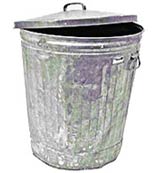
P-Series Fuels
P-Series fuels are a new type of biofuel that use up an overabundant resource: garbage. P-Series fuel is a blend of 35 percent natural gas liquids, 45 percent ethanol, and 20 percent methyltetrahydrofuan (MeTHF). The natural gas liquid is a substance called pentanes-plus, a liquid left over from the processing of natural gas, with butane added in winter months. MeTHF is made from biomass such as paper sludge, food wastes, agricultural waste, or yard waste, and serves as a co-solvent (substance that turns another into liquid). The fuel is a colorless clear blend with octane between 89 and 93, the same octane as gasoline. It can be formulated for winter or summer use. It can be used alone or mixed with gasoline in a flexible fuel vehicle (FFV).
Princeton Physicist Turns Garbage Into Miles Per Gallon
P-Series fuel was developed in the 1990s by Princeton University thermonuclear physicist Stephen Paul. He wanted to create a substitute for gasoline and thought that using garbage as fuel could work, simulatneously addressing three problems: the need for non-petroleum energy sources, solid waste management, and affordability. Using feedstock with a negative cost - that means waste that municipalities would otherwise pay to have hauled away - allows the fuel's selling price to be about the same as mid-grade gasoline. It also gives urban areas control over a large portion of the generated trash stream without relying on burning, burying, or bequeathing it to other states. The feedstock is not incinerated, but chemically digested, so there is no combustion with the accompanying toxic air emissions.
He gave the fuel its name in honor of Princeton University. Paul and his investors have founded the Trenton Fuel Works LLC, a sludge plant in New Jersey. Once financing is in place, their cooker will "digest" millions of tons of liquefied biomass and paper waste into a slippery chemical soup equivalent to light crude oil. Paul and investors have some options: sell the garbage as crude; further process the crude to make a variety of industrial solvents and chemical agents; get the P-Series fuel necessary to create a market for domestic clean-burning, renewable automotive fuel as government and individuals buy Flexible Fuel Vehicles that omnivorously burn both gasoline and renewable fuels.
How P-Series Fuel is Made
All ingredients except for the MeTHF can be purchased as bulk commodities from natural gas processors and ethanol producers. Fortunately, MeTHF is a high yield product of hydrolysis, a century-old process that had been utilized primarily in Germany and Russia during World War II to produce fermentable sugars that were used to manufacture ethanol fuel for vehicles. This approach has largely been abandoned because, upon formation, the sugars are rapidly destroyed, resulting in low ethanol yields. This problem is bypassed when producing MeTHF instead of ethanol, because sugar production is not necessary.
Pros and Cons of P-Series fuels
One of the advantages of P-series is that they are very easy to use. There is no need for any special fuel management because gasoline and P-series can be freely intermixed in any proportion with fuel that is already in the vehicle's fuel tank. So, even if P-series is not available at a particular location, simply fill up with gasoline.
Using P-Series fuels has several benefits. It decreases the amount of petroleum used to power vehicles. It makes use of waste that would otherwise have to be placed in a landfill, incinerated, or transported to some other location. P-Series fuels are easy to use. Fueling an FFV with P-Series fuel is identical to fueling a vehicle with gasoline. There is no need to monitor fuels because gasoline and P-Series fuels will work mixed together, so a car owner can fuel up at ordinary gas stations or at P-Series pumps without thinking about which is which. This is especially useful when traveling to areas where P-Series fuels are unavailable.P-Series fuels are not currently widely used. They are still quite new, and no car manufacturer has yet produced a ''P-Series specific'' FFV.
If consumers begin buying these fuels, however, they could be a good substitute for gasoline.
But P-Series fuels cannot be used in vehicles designed to burn gasoline only. FFVs designed to burn methanol or ethanol can burn it, but ordinary cars cannot. P-Series fuels are slightly more efficient than gasoline, but in practice, mileage for vehicles using P-Series fuels is about 10 percent less per gallon than those using gasoline.
The feedstock used to make MeTHF is chemically digested by the process of making it; as a result, the raw material is completely consumed and no emissions enter the air. Burning P-Series fuels in vehicles releases many fewer emissions than burning fossil fuels. In fact, P-Series fuels were added to the list of alternative fuels under the U.S. Energy Policy Act in 1999.
P-Series Fuels copyright 2011 Digtheheat.com
